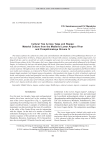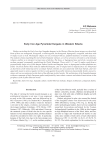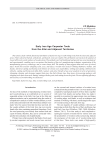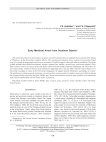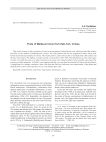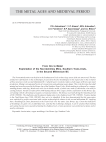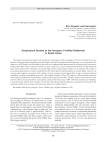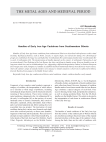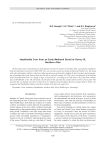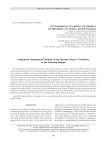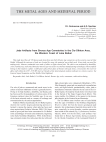The metal ages and medieval period. Рубрика в журнале - Archaeology, Ethnology & Anthropology of Eurasia
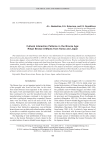
Cultural interaction patterns in the Bronze Age: ritual bronze artifacts from Korea and Japan
Статья
Бесплатно
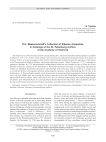
Статья научная
This study focuses on the drawings of items collected during D.G. Messerschmidt's fi rst multidisciplinary expedition to Siberia in 1719–1727. Pictures of the artifacts have been preserved among the documents held by the Academy of Sciences Archive in the personal papers of the traveler, which includes his fi eld journals, the appendices of his reports to the Pharmaceutical (Medical) Registry, and a large handwritten treatise “Sibiria Perlustrata” (1727), outlining the expedition's fi ndings. In 1728, Messerschmidt's archaeological collection was included as part of Peter the Great's Siberian Collection, exhibited at the Kunstkamera. Watercolor and pencil drawings and engravings depicting the exhibits are identifi ed. Handwritten descriptions and drawings of the items have made it possible to a certain extent to reconstruct the fi rst encyclopedist's Siberian archaeological collection, which perished during the 1747 fi re at the Kunstkamera. As Messerschmidt's graphic works demonstrate, he documented items spanning the time from the Bronze Age to the Late Middle Ages and covering the territory from the Urals to the Trans-Baikal region, including things imported from Western Europe, China, and Central Asia. Also, he collected archaeological items representing virtually all cultures of the Minusinsk Basin. It is concluded that in the fi rst third of the 18th century, Messerschmidt's collection was the world's largest and most representative assemblage of artifacts from northeastern Eurasia.
Бесплатно
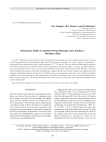
Decorative belts of Xianbei period nomads from Karban I, Northern Altai
Статья научная
In 1989–1990, five decorative belts worn by the Xianbei Period nomads were excavated from the Karban I cemetery in the Chemalsky District, Altai Republic. Their details (33 plaques, five buckles, six “units”, and two “pendant tips”) were found in four undisturbed graves of males (mounds 11, 27, 33, and 39). They are described with regard to function, decoration, and chronology. Parallels from the Altai and adjacent territories, dating to the late 1st millennium BC–early 1st millennium AD, are listed. A more precise attribution is the Early Xianbei Period (100–300 AD), correlating with the Bulan-Koby culture of the Altai. Available facts suggest that the style of these artifacts was influenced by the Xiongnu and Xianbei traditions. On the basis of the finds in situ, several variants of belt sets, some of which are hitherto unknown, have been reconstructed. The composition of the belts is unrelated to the owners' age and evidently mirrors their personal preferences. The results demonstrate the social relevance of the belts, since most were found in burials of top-ranking males.
Бесплатно
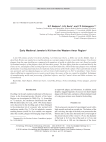
Early medieval jeweler's kit from the Western Amur region
Статья научная
A late 9th century jeweler's kit from dwelling 2 at Osinovoye Ozero, a Mohe site on the Middle Amur, is described. Bronze was smelted in a crucible placed on a ceramic support inside a vessel-like furnace. Nine bronze plaques from the same dwelling are compared with negatives of molds in which they were cast. Based on results of the elemental analysis of plaques, these fall into three groups. The fi rst differs from the other two by the source of ore, and plaques of the second group were recast more than once. Most Turkic type plaques were evidently destined for recasting into Mohe ornaments. The latter include one openwork and two fi gured plaques as well as bronze bells found in 2012 in dwelling 3. Because bronze items differing in composition were recast several times, the source of ore cannot be identifi ed. Techniques of manufacturing molds and facing of plaques, used by Central Asian and Mohe artisans, are reconstructed.
Бесплатно
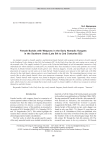
Статья научная
An attempt is made to classify, analyze, and interpret female burials with weapons in the graves of early nomads in the Southern Urals, dating to late 5th–2nd centuries BC. In the Early Iron Age, this vast region was a center of the nomadic elite. The sample includes 23 graves with 24 buried individuals at well documented cemeteries. Only individuals for whom skeletal sex indicators are available have been included. Criteria and opinions are revised. Weapons in female burials include mostly quiver sets; whereas daggers, swords, and spearheads are rare. The placement of weapons was the same as in male burials: bladed weapons were placed on the right side, with hilts directed to the right hand, whereas quivers were found mostly on the left side. The remaining funerary items were exactly like in other female burials: there were numerous ornaments, bronze mirrors, spindle whorls, and stone altars. Female burials with weapons were found in kurgans regardless of social status. Apparently, those women represented all social strata, from elite to low-ranking nomads. Nothing indicates the existence of female military units, which, however, does not imply that women took no part in armed confl icts or did not use weapons to protect themselves and their homes.
Бесплатно
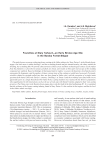
Foundries at Stary Tartas-5-an early bronze age site in the Baraba forest-steppe
Статья
This study focuses on areas evidencing bronze casting at the Odino culture site, Stary Tartas-5, in the Baraba foreststeppe. One such area is within dwelling 1 and has a smelting hearth and pits situated nearby; the other, outside the dwelling, has a smelting kiln. We provide characteristics of these areas and their archaeological context. Each artifact from the foundries is described in detail, parallels are listed, and results of binocular microscopy of the molding compound are outlined. Based on fi ndings of thermogravimetric studies, we assess the functions of technical pottery represented by fragments, and the number of times various items of the casting set could have been used. Previously, crucibles shaped as straight-walled jars have not been found at Odino sites, with the exception of a single intact specimen from burial 286 at the Tartas-1 cemetery. Dwelling 1 at Tartas-5 and the workshop associated with it were apparently parts of a single household. The Odino bronze casting tradition was retained by the Krotovo population, who supplemented it with innovations, such as the use of oval cups with thicker bottoms adapted to their own casting practices. The Odino sites in the Baraba forest-steppe date to the fi rst half of the third millennium BC. It is concluded that the evidence of the bronze casting industry found at Stary Tartas-5 is the earliest in that region, and that its level in the Odino culture was high.
Бесплатно
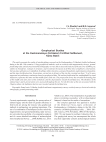
Geophysical studies at the Kushmanskoye (Uchkakar) fortified settlement, Kama basin
Статья
Бесплатно
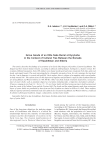
Статья научная
This article describes the findings of excavations of an Early Saka kurgan at Kyrykoba, Eastern Kazakhstan. The kurgan had been looted; human remains, according to physical anthropologists, belonged to a mature woman. Her cranium exhibited trepanation. Some 200 artifacts were found, mostly gold and stone ornaments (belt clips, gold seed beads, and simple beads). The most interesting find is a bimetallic pin made of iron. Its rod is missing; the tiny head, less the 1 cm in diameter, is covered with gold foil. On its surface, there is a figure of an ungulate with a curved antler, its body twisted 180°. This stylistic device in the depiction of ungulates and predators is typical of the Scythian-Siberian art of Kazakhstan and Western Siberia in 700–300 BC. Other rare finds include ornaments made from a cretaceous layer of oyster shells, such as pendants shaped as oval plates imitating tusks, or figurines of predatory animals— 20 pieces, ranging in size from 0.4 × 0.4 to 2.5 × 2.5 cm. Oyster shells with thick cretaceous layers had been procured from the coasts of the Indian Ocean and the Persian Gulf. The beads and the animal figurine made from cretaceous layers of oyster shells are paralleled by those from an Early Scythian era burial at Gilevo-10, Altai. These artifacts indicate regional and intracontinental trade and cultural ties in Eastern Kazakhstan and Western Siberia, evidenced by similar technological traditions, images, compositions, and decorative motifs.
Бесплатно

